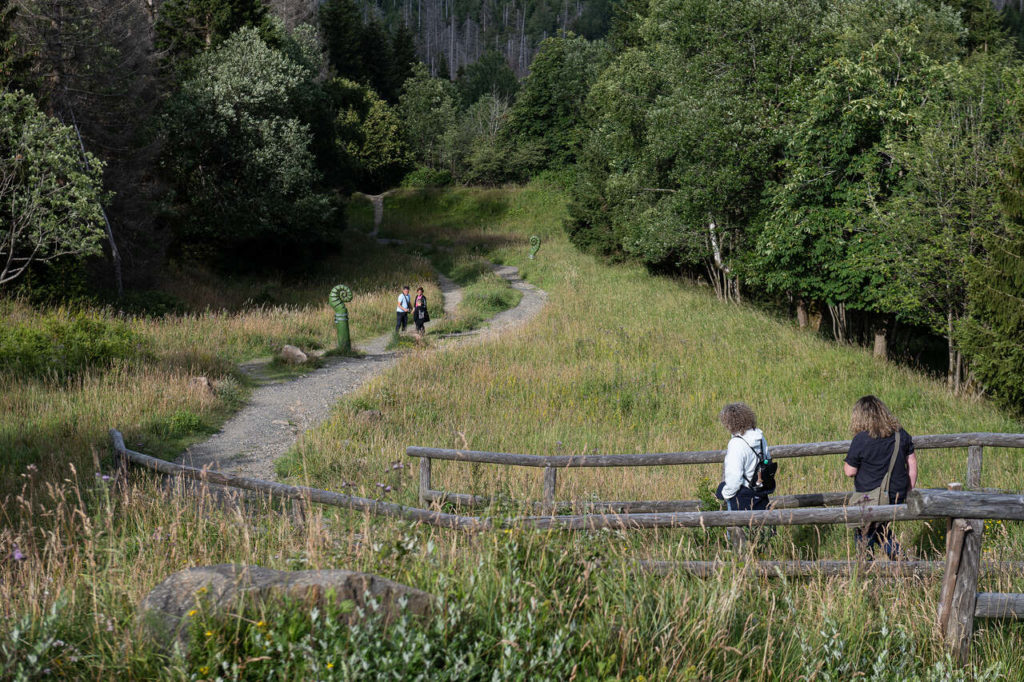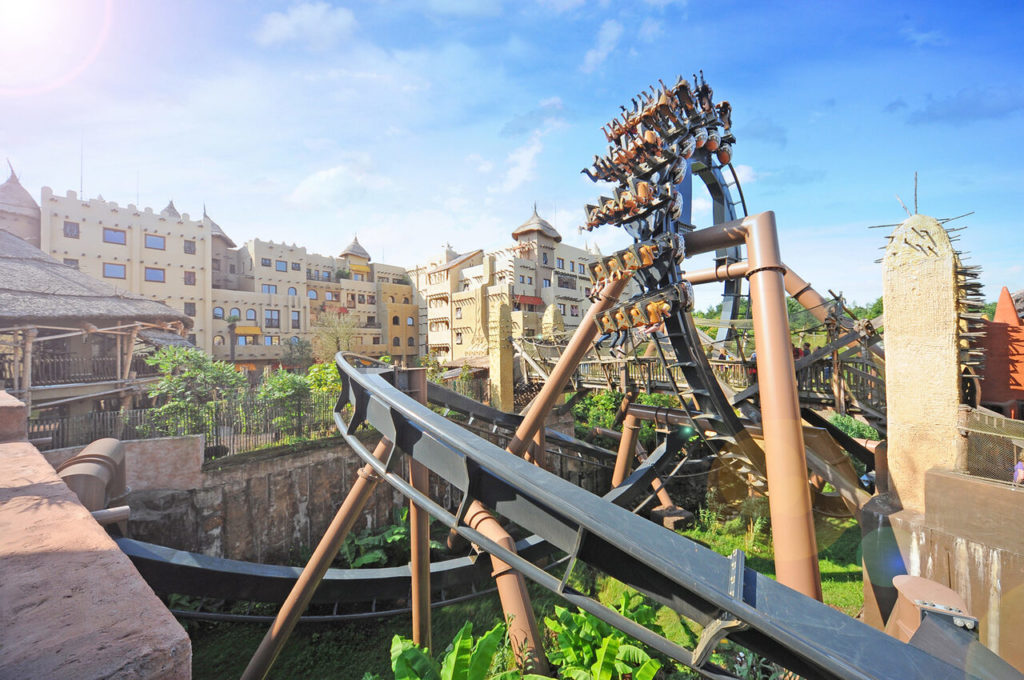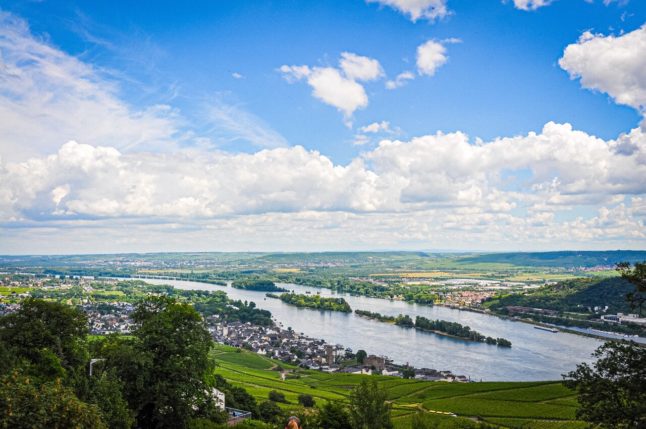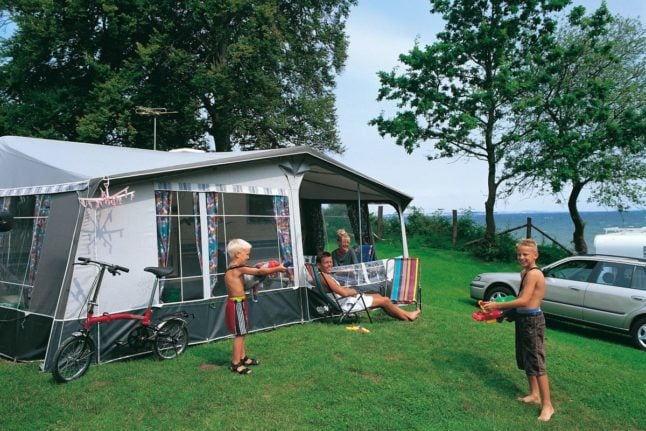Rüdesheim am Rhein
Nestled in the scenic Rhine Valley, Rüdesheim am Rhein is a picturesque wine town full of historical charm.
Surrounded by terraced vineyards and rolling hills, the town’s streets are lined with colourful half-timbered houses, inviting cafes, and traditional taverns. The lively Drosselgasse, a narrow lane usually brimming with crowds, offers visitors plenty of spots to taste local wines and cuisine.
Wine enthusiasts will also enjoy a visit to the Rüdesheim Wine Museum, where they can learn about the region’s winemaking heritage and sample local wines in the cellars.
READ ALSO: 9 of the best day trips from Frankfurt with the €49 ticket
If you’re staying a little longer, you can even take an evening cruise along the Rhine River to see the town’s unique nighttime charm.
You can reach Rüdesheim am Rhein in less than two hours with regional transport from Frankfurt am Main, by taking the S1 or S2 from the main station, followed by the RB10.
Usedom Island
Renowned for its long sandy beaches and quaint seaside resorts, Usedom Island is the perfect summer destination.
With a generous stretch of approximately 42 kilometres of sandy beaches, the island provides ample space for visitors to unwind and enjoy the Baltic Sea.
READ ALSO: Why you should visit the German state of Mecklenburg-Western Pomerania
Nature enthusiasts will find hiking trails and lush landscapes in the Usedom Nature Park and those with an interest in history can take a trip to the Peenemünde Historical and Technical Museum to explore the history of rocket development and World War II.
The Kaiserbäder villages, including Ahlbeck, Heringsdorf, and Bansin, are well worth a visit for their inviting promenades and spa facilities.
With regional transport from Berlin – the S2 followed by the RE3 and local buses on Usedom – you’ll need around 5 hours to reach the Island, making the option to stay over night on the island look particularly inviting.
The Harz Mountains
The Harz Mountains, often simply referred to as the Harz, are a picturesque low mountain range located in northern Germany, spanning the states of Lower Saxony, Saxony-Anhalt, and Thuringia. Renowned for its natural beauty and captivating landscapes, it‘s one of the most popular tourist destinations in the country.

As well as offering breathtaking natural landscapes and hiking routes aplenty, the region is dotted with charming medieval towns and villages such as Goslar, Wernigerode, Quedlinburg, and Braunlage, where well-preserved timber-framed houses, historic churches, and quaint cobblestone streets transport visitors to a bygone era.
The Harz is also famous for its narrow-gauge steam railways, including the Harz Railway (Harzer Schmalspurbahnen) and the Brocken Railway (Brockenbahn), which offer scenic journeys through the mountains.
READ ALSO: Nine of the best day trips from Berlin with the €49 ticket
From Berlin you can use the €49 ticket to take the RE1 followed by the RE21, taking approximately 3 hours to reach Wernigerode Hauptbahnhof. Travellers coming from Bremen can opt for the RE1, RE8, or RE21, with a travel time of just under 3 and a half hours. Those coming from Hanover can reach the Harz in under 2 hours by taking the RE10 and RE21.
Zugspitze
Germany’s highest peak can make a great getaway on hot summer days.
With an elevation of 2,962 metres, the mountain top offers an unforgettable panorama that stretches across Germany, Austria, Switzerland, and even Italy on clear days.
If you’re not up to hiking to the summit, you can reach it via a cable car or a thrilling cogwheel train ride, each offering its own unique perspectives of the surrounding Alpine landscape.
READ ALSO: REVEALED: Germany’s longest regional train journeys with the €49 ticket
The Zugspitze’s charm extends beyond its natural beauty: the mountain is home to cosy restaurants and cafes where visitors can savour local Bavarian delicacies while gazing at the stunning landscape.
From Munich, you can reach the Zugspitze by taking the RB26 to the town of Garmisch-Patenkirschen. From there you can take cable car, bus or even hike up the mountain.
Timmendorfer Strand
The long, sandy beach and charming promenade at Timmendorfer Strand is a perfect summer destination for those in the north of Germany.
Visitors can enjoy water-based activities such as sailing, windsurfing, and stand-up paddleboarding at the beach, or simply relax in one of the many Strandkörber (“beach chairs”).

The Sea Life aquarium is another popular attraction, offering a variety of marine life and interactive experiences for all ages, while Timmendorfer Platz, the town’s central square, hosts events, concerts, and markets throughout the summer.
From Hamburg, visitors can reach the beach in less than an hour and a half with the RE8 or RE80 and the RB85.
The Black Forest
Schwarzwald, or The Black Forest, is a haven for nature lovers, boasting lush forests, rolling hills, and crystal-clear lakes.
Visitors can explore a network of well-marked hiking trails that wind through the forests, leading to stunning viewpoints and charming villages nestled in the scenic landscape. For more adventurous explorers there are plenty of opportunities to go mountain biking or horse riding in the forest.
Those who just want to relax, can enjoy a picnic by the tranquil lakes or swim in refreshing waters.
The region is also full of charming towns and villages and plenty of opportunities to try come local delicacies – including the famous Black Forest gateau.
From Karlsruhe you can take the S8 to Forbach in the heart of the Black Forest in just over an hour.
Phantasialand
Phantasialand is one of Germany’s best-loved theme parks, which has become a favourite destination for families and thrill-seekers alike.
The amusement park is renowned for its world-class roller coasters and exhilarating rides, including the iconic Black Mamba, the gravity-defying Taron, and the immersive Chiapas.

Beyond the thrilling rides, Phantasialand takes pride in its attention to detail, from the lush landscaping to the mesmerising shows and performances for audiences of all ages to its diverse themed areas, each offering a unique and immersive experience.
From Cologne, you can reach Phantasialand in less than an hour with the RB48 or RB26 followed by the 707 bus. From Düsseldorf, you can reach the park in less than two hours with the S8 or S12, followed by the RE13 and then the 707 bus.
Baldeneysee
Baldeneysee is an expansive lake spanning over 2.6 square kilometres, offering a blissful escape from the urban hustle in Essen.
Its picturesque shores, surrounded by lush greenery and rolling hills, invite leisurely strolls, picnics, and waterside relaxation.
But for those who like to stay active, there are sailing, kayaking, and paddle boarding opportunities abound, offering the change to explore the lake’s hidden coves and inlets.
READ ALSO: Which foreign countries can you visit with Germany’s €49 ticket?
Along the waterfront, the inviting Baldeneysee Promenade is perfect for cycling or meandering walks and the lake has plenty to offer in the way of cafes, restaurants, and vibrant beach bars.
Adventure seekers can explore the nearby Baldeneysteig trail, featuring stunning views of the Ruhr Valley landscapes.
From Essen, you can reach the lake with the 145 bus in under an hour.




 Please whitelist us to continue reading.
Please whitelist us to continue reading.
Er, Garmisch-Partenkirchen 🙂